

Johns Hopkins University (JHU) continues to pad its space community résumé with their interactive map, “The map of the observable Universe”, that takes viewers on a 13.7-billion-year-old tour of the cosmos from the present to the moments after the Big Bang. While JHU is responsible for creating the site, additional contributions were made by NASA, the European Space Agency, the National Science Foundation, and the Sloan Foundation.
Follow along as NASA launches the Mars 2020 Mission, perhaps the most ambitious hunt yet for signs of ancient life on Mars. The spacecraft will blaze into the Martian atmosphere at some 12,000 miles per hour and attempt to lower the Perseverance Rover in the rocky Jezero Crater, home to a dried-up river delta scientists think could have harbored life. Perseverance will comb the area for signs of life and collect samples for possible return to Earth. Traveling onboard is a four-pound helicopter that will conduct a series of test flights—the first on another planet. During its journey, Perseverance will also test technology designed to produce oxygen from the Martian atmosphere, in hopes that the gas could be used for fuel—or for humans to breathe—on future missions. © 2020 WGBH Educational Foundation All rights reserved This program was produced by GBH, which is solely responsible for its content. Some funders of NOVA also fund basic science research. Experts featured in this film may have received support from funders of this program. Funding for NOVA is provided by Draper, the David H. Koch Fund for Science, the NOVA Science Trust, the Corporation for Public Broadcasting, and PBS viewers. This program is made possible by viewers like you. Support your local PBS station here:

Artist's impression of the Mars 2020 Rover. Credit: NASA.

The microphone for the upcoming Mars mission will be attached to the SuperCam, seen here in this illustration zapping a rock with its laser. Credit: NASA/JPL-Caltech
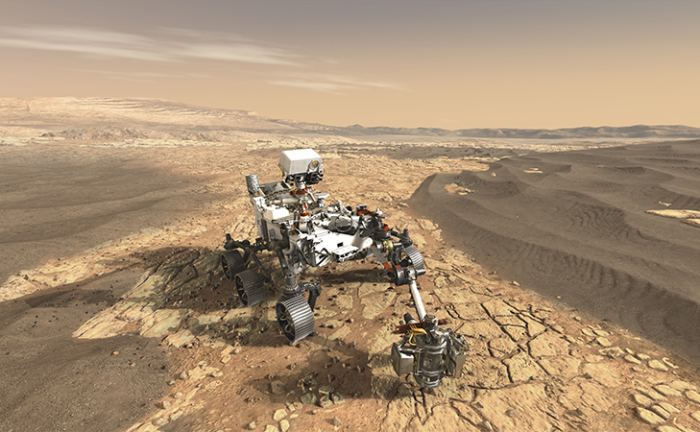

Engineers testing the spacecraft that will carry the Mars 2020 rover to the Red Planet. Credit: NASA/JPL-Caltech

The components that make up the Mars 2020 spacecraft, labelled (left) and unlabeled (right). Credit: NASA/JPL-Caltech
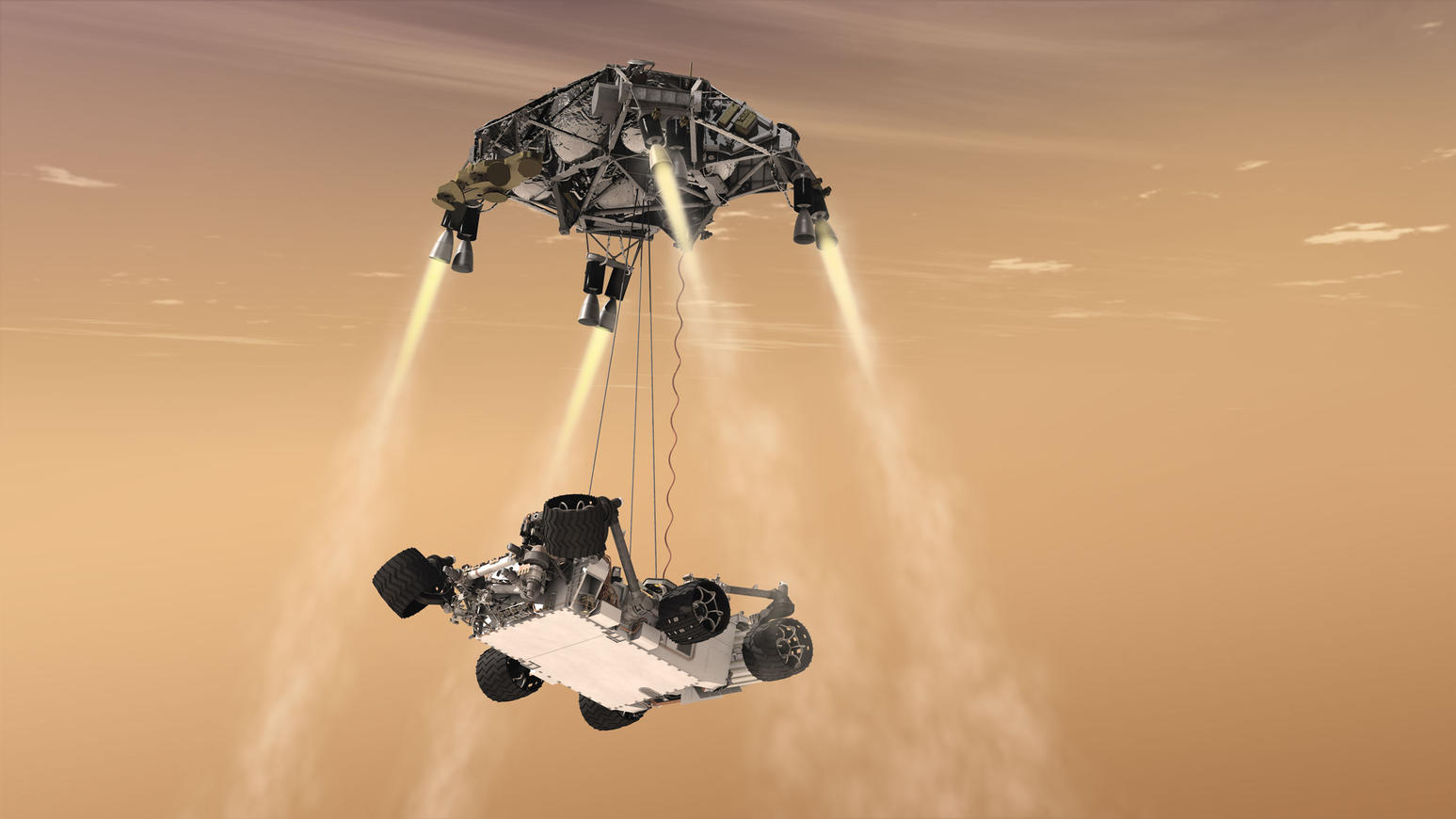
Artist’s impression of the Mars 2020 with its sky crane landing system deployed. Credit: NASA/JPL

Back in November 2018, NASA announced that the Mars 2020 rover would land in the Jezero Crater. Jezero Crater is a geologically diverse area, with an alluvial fan of sediment deposited by an incoming river. That sediment may contain preserved ancient organic molecules, and the deposit is clearly visible in satellite images of the Crater.

A composite image of the Jezero Crater from the MRO’s CRISM instrument and its Context Camera. Colors have been added to show minerals. Green represents carbonates, that minerals that preserve fossils so well here on Earth. The red is olivine sand eroding out of carbonate-containing rocks. Image Credit: NASA/JPL-Caltech/MSSS/JHU-APL/Purdue/USGS

The marginal carbonates are outlined in red in this image. Image Credit: NASA/MRO/ Horgan et. al. 2019.

Jezero crater is the landing spot for NASA’s upcoming 2020 rover. The crater is a rich geological site, and the 45 km wide (28 mile) impact crater contains at least five different types of rock that the rover will sample. Some of the landform features in the crater are 3.6 billion years old, making the site an ideal place to look for signs of ancient habitability.

This map of Mars was created using data from the Mars Orbiter Laser Altimeter (MOLA) on the Mars Global Surveyor. The Isidis Basin, which contains the Jezero Crater, is on the middle right. Image Credit: NASA / JPL / GSFC. Map by Emily Lakdawalla at the Planetary Society.

A topographical map of Isidis Planitia. Image Credit: Martin Pauer (Power) – plotted using GMT and gridded MOLA data archive meg0031t.grd, , WIKIPEDIA Public Domain
An animated flyover of the Martian surface explains why Mars’ Jezero Crater, a 28-mile-wide ancient lake-delta system, is the best place for the Mars 2020 rover to find and collect promising samples for a possible future return to Earth. For more about the mission, please visit
by PAUL PATTON on MARCH 17, 2015


We’ve known for some time that NASA is sending a helicopter to Mars. The vehicle, called the Mars Helicopter, is undergoing flight testing at NASA’s Jet Propulsion Laboratory in California. The little helicopter will make its eventual way to Mars as part of the Mars 2020 Rover missio

This image of the flight model of NASA's Mars Helicopter was taken on Feb. 14, 2019, in a cleanroom at NASA's Jet Propulsion Laboratory in Pasadena, California. The aluminum base plate, side posts, and crossbeam around the helicopter protect the helicopter's landing legs and the attachment points that will hold it to the belly of the Mars 2020 rover. (Image: © NASA/JPL-Caltech)
Video file: NASA's Mars Helicopter Completes Flight Tests from JPLraw on Vimeo.
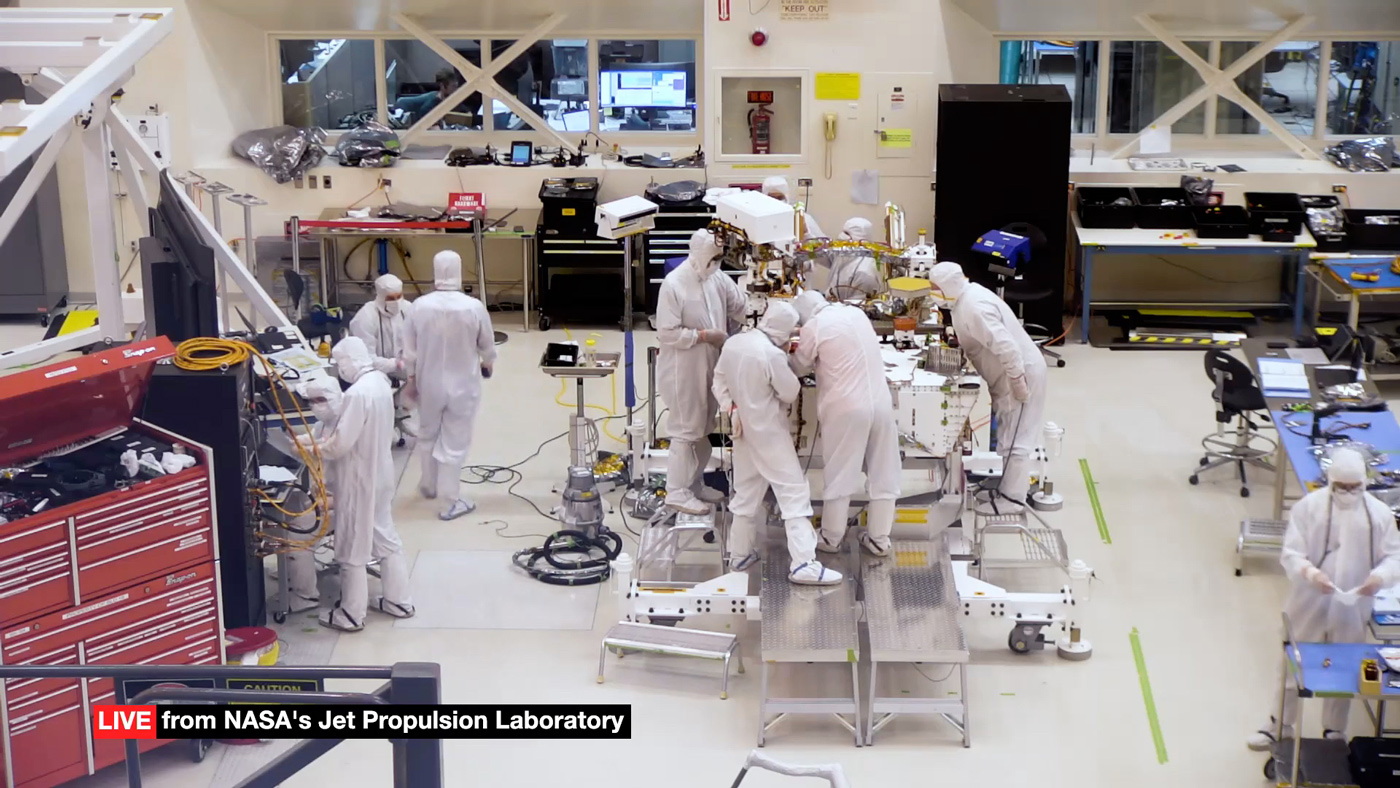
(As of June 2019) NASA’s next mission to the surface of Mars is called the 2020 rover (in case you didn’t know already.) It’s planned launch date is July 17th, 2020, and it should land at Jezero Crater on Mars on February 18th 2021. The rover is still under construction at the Jet Propulsion Lab in Pasadena, California.

Not much happening at 1:13 PST, Friday June 7, 2019. Image Credit: NASA/JPL

In this image from the JPL facility where the 2020 rover is being worked on, 2 people are doing something and talking about it. Fascinating! Image Credit: NASA/JPL

Here’s someone sitting at a computer doing something. Hey! That’s what I do! Image Credit: NASA/JPL

The Mars 2020 rover's power system, called a Multi-Mission Radioisotope Thermoelectric Generator (MMRTG), will be inserted into the aft end of the rover between the white panels with gold tubing. (Image credit: NASA/JPL-Caltech)

In this photo, taken June 1,2019 an engineer at NASA's Jet Propulsion Laboratory in Pasadena, California, works on the Mars 2020 rover. (Image credit: NASA/JPL-Caltech)

An engineer works on attaching NASA's Mars Helicopter to the belly of the Mars 2020 rover — which has been flipped over for that purpose — on Aug. 27, 2019, at the Jet Propulsion Laboratory in Pasadena, California.(Image: © NASA/JPL-Caltech ) The first-ever off-Earth helicopter just hooked up with its traveling compani Engineers at NASA's Jet Propulsion Laboratory (JPL) in Pasadena, California, attached the tiny Mars Helicopter to the agency's car-size Mars 2020 rover today (Aug. 28, 2019), agency officials announced.

Artist’s impression of the Mars 2020 with its sky crane landing system deployed. Credit: NASA/JPL
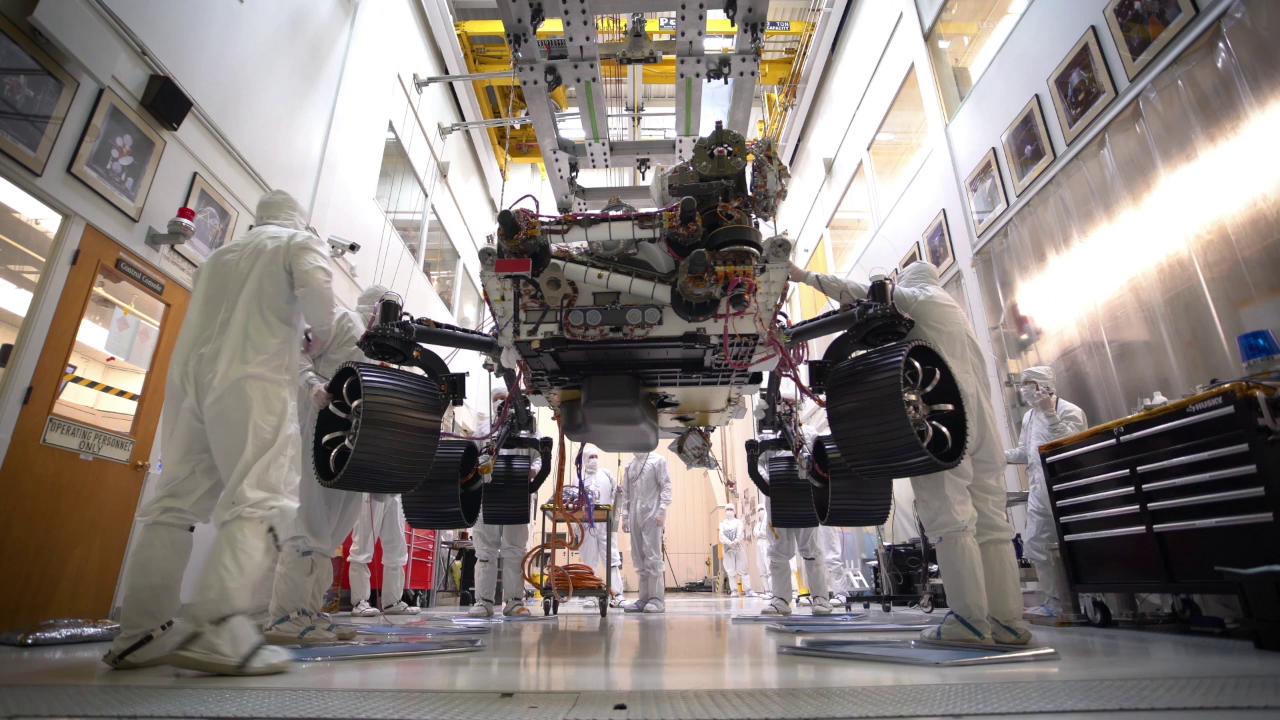
This coming July 2020, the Mars 2020 rover will launch from Cape Canaveral, Florida, and begin its journey to the Red Planet. After it touches down in the Jezero Crater, the rover will commence science operations similar to what Curiosity has been doing since 2012. This will consist of driving over rough terrain, sampling the atmosphere, collecting drill samples, and subjecting them to chemical analysis.
A time-lapse video, taken JPL, captures the first time NASA's Mars 2020 rover has carried its full weight on its legs and wheels. For more information about the mission, visit

This artist’s concept depicts NASA’s Mars 2020 rover exploring Mars. Credit: NASA

A NASA team proposed building an airplane called ARES that could stay flying on Mars for an hour thanks to jet propulsion. However, the difficulties of Mars' atmosphere meant it would fly just once. Credit NASDA


NASA's Mars Ingenuity helicopter drone will deploy from the Perseverance rover and conduct a series of test flights, paving the way for future aircraft to fly on Mars. credit:NASA

Flying low over the surface of Mars. Don’t tell me you haven’t dreamed about it, especially with some of the ‘Mars flyover’ videos that have been produced over the years using data from the orbital missions. And if all goes well – global pandemic not withstanding — a helicopter will be on its way to the Red Planet in just a few months.(this was posted early July 2020)
NASA’s Mars Helicopter, Ingenuity, is set to arrive at the Red Planet on Feb. 18, 2021. Its mission: to demonstrate the first powered flight on another world. For more information, visit Credit: NASA/JPL-Caltech
The first aircraft that will attempt powered flight on another world has a new name! Meet Ingenuity – NASA’s Mars Helicopter. And the inspiration for the name? We owe that credit to Vaneeza Rupani, an 11th grader from Northport, Alabama. Learn how Vaneeza helped name the helicopter and how this experiment plans to make its high-flying debut on the Red Planet with Mars Helicopter Project Manager MiMi Aung. NASA’s Perseverance Mars rover and the Ingenuity helicopter will launch together to Mars in summer 2020. For more information on the helicopter:

An engineer works on attaching NASA’s Mars Helicopter to the belly of the Mars 2020 rover – which has been flipped over for that purpose – on Aug. 27, 2019, at the Jet Propulsion Laboratory in Pasadena, California. Credit: NASA/JPL-Caltech.

When NASA’s new Perseverance Martian rover launches in a little over a month it will have a small robotic stow-away on board. Ingenuity is a small helicopter, with a fuselage about the size of a softball and two extending rotors that measure about 4 feet across. It was attached to the bottom of the rover’s chassis in April, and NASA recently released details about it’s technically challenging release process.

Image describing various subsystems of the Ingenuity elicopter. Credit: NASA/JPL-Caltech
MiMi Aung, the Autonomous Systems Deputy Division Manager at JPL, presented the Mars Helicopter Scout at the Keck Institute for Space Studies lecture on April 1, 2015. The Mars Helicopter Scout is a current proposal to demonstrate helicopter flight at Mars on the Mars 2020 mission.The Mars Helicopter Scout will scout ahead of a planetary surface rover to provide high-resolution aerial images of the terrain for science and operational purposes. This talk described the scope of the Mars Helicopter Scout proposal, the signficant science and operational benefits of a helicopter in planetary surface exploration, and the technical design overview of Mars Helicopter Scout. The talk concluded with examples of feedforward applications of a planetary helicopter to future missions, with an invitation for lecture attendees to join in further envisioning the much bigger, broader future applications offered by this addition of an aerial dimension to the state-of-practice surface rovers and orbiters in planetary exploration today.
NASA's Ingenuity helicopter is traveling to Mars attached to the belly of the Perseverance rover and must safely detach to begin the first attempt at powered flight on another planet. Tests done at NASA’s Jet Propulsion Laboratory and Lockheed Martin Space show the sequence of events that will bring the helicopter down to the Martian surface. For more about the Mars helicopter, visit Credit: NASA/JPL-Caltech and Lockheed Martin Space

Ingenuity can be seen in the lower central part of this image of the underside of the Perseverance rover. Credit: NASA/JPL-Caltech

It’s time to update the rules. That’s the conclusion of a panel that examined NASA’s rules for planetary protection. It was smart, at the dawn of the space age, to think about how we might inadvertently pollute other worlds with Earthly microbes as we explore the Solar System. But now that we know a lot more than we did back then, the rules don’t fit.

The Viking landers were sterilized in a purpose-built oven so they wouldn’t contaminate Mars. Image Credit: NASA

NASA engineers working on the Mars 2020 rover’s sample return mechanism. What kind of protection is necessary when these samples return to Earth? Image Credit: NASA

These dark streaks, called recurring slope linae (RSL) look like seasonal water seepages, a great place for Curiosity to explore habitability on Mars. But the Office of Planetary Protection thought otherwise. Image Credit: NASA/JPL-CALTECH/UNIV. OF ARIZONA

70 days from now,(as of May 12,2020 ) the next launch window to Mars opens. That’s when NASA will launch their Perseverance Rover. New images from NASA show the advanced rover being put into the fairing, readying it for its long journey.

NASA’s Perseverance Rover in a clean room at Kennedy Space Center. The rocket-powered descent stage is sitting atop the rover, in this image from April 29th, 2020. This is the first step in the vehicle stacking process. Image Credit: NASA/JPL-Caltech

This image is from the Curiosity Rover, but Perseverance will use the SkyCrane method too. Image Credit: NASA/JPL
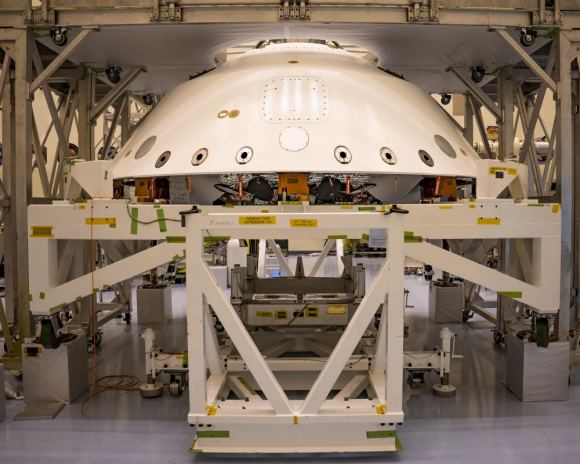
The cone-shaped back shell for NASA’s Perseverance rover mission sits on a support structure in this April 29, 2020, image from Kennedy Space Center in Florida. Along with the heat shield, the back shell provides protection for the rover and descent stage during Martian atmospheric entry. Portions of the descent stage and rover, stacked one on top of the other, can be seen in the open area directly below the lower edge of back shell. Image Credit: NASA/JPL-Caltech

The Perseverance rover will land at the Jezero Crater. This is an orbital picture of the Jezero crater, showing its fossil river delta. Credit: NASA/JPL/JHUAPL/MSSS/BROWN UNIVERSITY

On Thursday, July 30th, NASA launched the most sophisticated Mars rover ever built atop a United Launch Alliance (ULA) Atlas V rocket from Space Launch Complex 41 at Cape Canaveral Air Force Station, Florida.This mission includes the Perseverance rover (Curiosity‘s sister vehicle) and the Ingenuity Mars Helicopter, both of which are being flown on a seven-month journey by the Mars 2020 spacecraft.
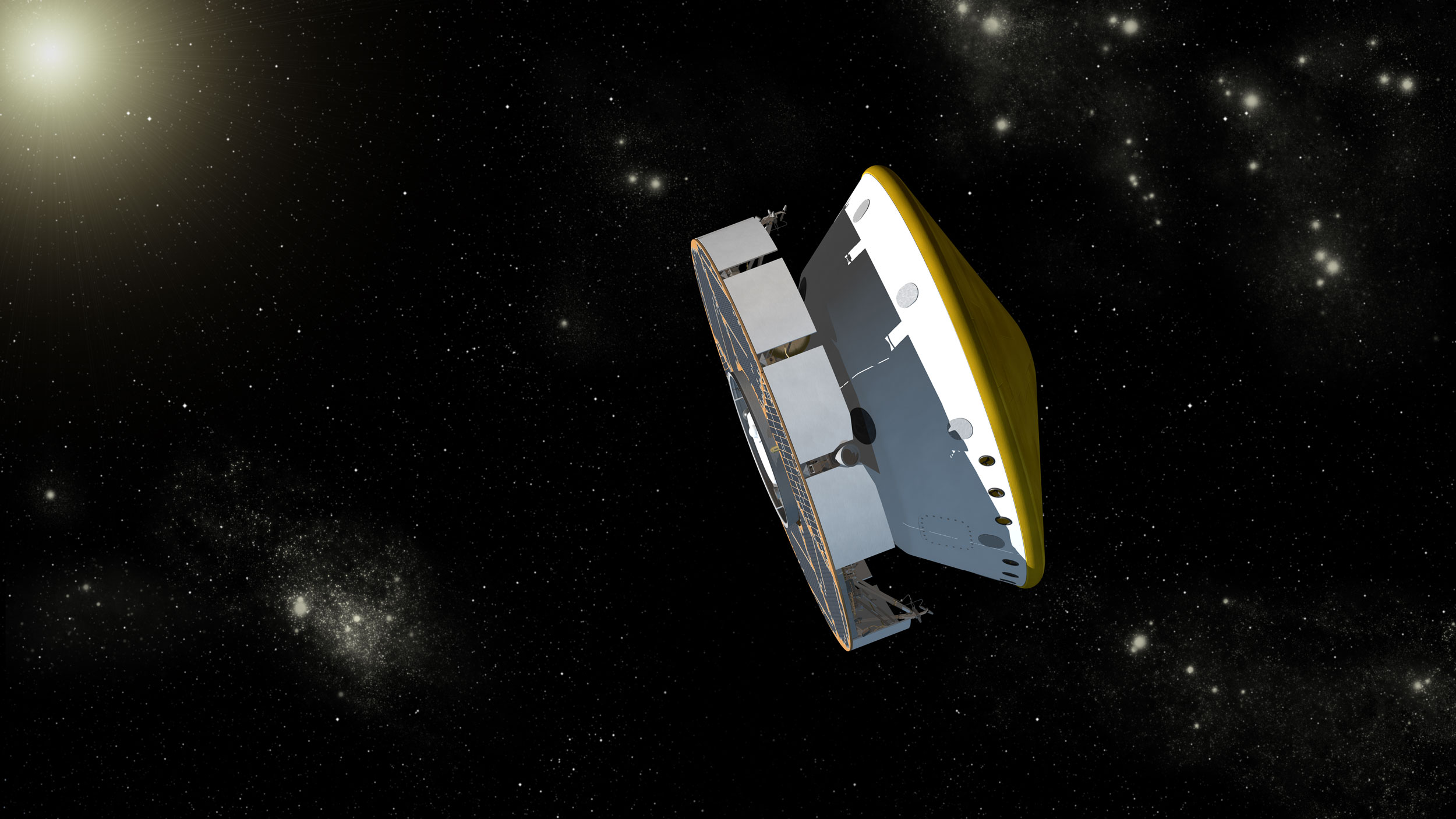
Artist’s impression of Mars 2020 spacecraft. Credit: NASA/JPL-Caltech
NASA’s Perseverance Rover began its long journey to Mars today (July 30, 2020) by successfully launching from Cape Canaveral Air Force Station on a ULA Atlas V rocket. It now begins its seven-month journey to the Red Planet, landing there on Feb. 18, 2021. Perseverance will seek signs of ancient microbial life on Mars along with collecting samples for future return to Earth and demonstrating key technologies to help prepare for future robotic and human exploration. Also flying with Perseverance is NASA’s Ingenuity helicopter, which will attempt to show controlled flight is possible in the very thin Martian atmosphere. For more about Perseverance, visit For more about Ingenuity, visit Credit: NASA/JPL-Caltech
Watch as NASA-JPL engineers test the Sample Caching System on the Perseverance Mars rover. Described as one of the most complex robotic systems ever built, the Sample and Caching System will collect core samples from the rocky surface of Mars, seal them in tubes and leave them for a future mission to retrieve and bring back to Earth. The team is on track to launch Perseverance in July 2020 and land in Mars’ Jezero Crater in February 2021. For more information on the Mars 2020 Perseverance mission, please go to: Credit: NASA-JPL/Caltech
NASA's Mars 2020 Perseverance mission captured thrilling footage of its rover landing in Mars' Jezero Crater on Feb. 18, 2021. The real footage in this video was captured by several cameras that are part of the rover's entry, descent, and landing suite. The views include a camera looking down from the spacecraft's descent stage (a kind of rocket-powered jet pack that helps fly the rover to its landing site), a camera on the rover looking up at the descent stage, a camera on the top of the aeroshell (a capsule protecting the rover) looking up at that parachute, and a camera on the bottom of the rover looking down at the Martian surface. The audio embedded in the video comes from the mission control call-outs during entry, descent, and landing. For more information about Perseverance, visit
Perseverance Lands on Mars
Information on Perseverance Lands on Mars
Credit: NASA/JPL-Caltech
<>
Latest images from the mission Mars 2020.(March 2021) This new panorama was captured by Mastcam-Z right-eye 110-mm telephoto zoom lens and this mosaic stitched together from 79 individual images is camera's first high-resolution pano taken on Mars. The main panorama image is from the afternoon of Sol 4. Your feedback is very much appreciated. Photo Credit: NASA/JPL-Caltech/ASU/MSSS Video Editor: DaVinci Reslove 16
<>
Who knows what a resident of Mars would have thought if that morning of February 18, 2021 (Earth time) had suddenly seen a colorful drape blooming in the sky with something hanging down towards the ground, and then transformed into a fire-breathing dragon raising whirlwinds of sand...Here is the clip of Mars 360° Panorama. . A quiet Martian gentleman, an inhabitant of what we call Jezero Lake, frightened and intrigued by something that didn't even remotely resemble the fall of one of the usual meteorites he was accustomed to... - - ►Subscribe for more videos Business Enquiries ► We have Another Channel ► "Down The Rabbit Hole" - - How do you say? Impossible, on Mars there is no intelligent life? Ok, but grant me at least the presence of a couple of small animals that run away scared... Even this would have been enough to give a warm touch of life to what instead appeared only as the landing of a machine on a planet completely indifferent. Perseverance, in fact, landed on the sands of Isidis Planitia in complete solitude. Only the sound of the wind to welcome the visiting ambassador of the Earth. A bit sad, isn't it? But at least this time, albeit at a distance of millions of kilometers, someone was there to enjoy the show (almost) live! Half a billion earthlings, say the statistics, who for the first time, thanks to the cameras and microphones placed on board the probe could follow the landing as if they were there on the red planet... A month after those incredible moments, let's go to review everything, and get ready to enjoy (among the rest) a long and exciting high-resolution sequence of the Martian horizon ride… Perseverance mission diary. The rover lands on Mars on February 18, 2021, after an orbital pursuit lasted seven months and 384 million kilometers. Unfortunately, there is still no possibility to receive "live" images... and we, who follow the event from Earth, have to be content to rejoice together with the guys at the control center, who emphasize with shouts of jubilation every obstacle overcome in the descent on the ancient bottom of the Jezero crater... Three days later, on February 21, NASA made public the footage documenting all phases of the arrival: a little more than three minutes in which the cameras show the deployment of the parachute, the detachment of the heat shield, the Martian soil that gets closer and closer and the rover that is lowered on the ground by the Skycrane of the descent module. - - "If You happen to see any content that is yours, and we didn't give credit in the right manner please let us know at Lorenzovareseaziendale@gmail.com and we will correct it immediately" "Some of our visual content is under an Attribution-ShareAlike license. in its different versions such as 1.0, 2.0, 3,0, and 4.0 – permitting commercial sharing with attribution given in each picture accordingly in the video." Credits: Ron Miller Credits: Mark A. Garlick / MarkGarlick.com Credits: Nasa/Shutterstock/Storyblocks/Elon Musk/SpaceX/ESA/ESO Credits: Flickr #InsaneCuriosity #Mars360 #MarsPanorama
NASA's Perseverance Rover has 23 cameras on-board. And so far, it's captured more than 15,000 raw images of the Red Planet. That number continues to grow. We put together a compilation of some of our favorites. You can skip around by camera in the chapters below. Check it out! 00:01 Intro 00:25 Parachute Up-Look Camera 00:55 Descent Stage Down-Look Camera 01:28 Rover Up-Look Camera 02:19 Rover Down-Look Camera 02:46 Lander Vision Camera 03:08 Navigation Camera Right 04:50 Navigation Camera Left 06:26 Front Hazcam Left 07:47 Front Hazcam Right 09:12 Rear Hazcam Right 10:19 Rear Hazcam Left 11:09 Mastcam-Z Right 13:29 Mastcam-Z Left 16:22 Sherloc Watson Camera

On April 30th, 2021, the Ingenuity Mars Helicopter achieved yet another milestone and set new records with its fourth flight on Mars. This time around, the helicopter took off at 12:33 AM Mars Standard Time (10:49 AM EDT; 07:49 AM PDT) and ascended to an altitude of 5 meters (16 feet). It then traveled south for approximately 133 meters (436 feet) and then back in the space of about two minutes (117 seconds).
NASA’s Ingenuity Mars Helicopter takes off and lands in this video captured on April 25, 2021, by Mastcam-Z, an imager aboard NASA’s Perseverance Mars rover. As expected, the helicopter flew out of its field of vision while completing a flight plan that took it 164 feet (50 meters) downrange of the landing spot. Keep watching, the helicopter will return to stick the landing. Top speed for today's flight was about 2 meters per second, or about 4.5 miles-per-hour. The Ingenuity Mars Helicopter was built by JPL, which also manages this technology demonstration project for NASA Headquarters. It is supported by NASA’s Science Mission Directorate, Aeronautics Research Mission Directorate, and Space Technology Mission Directorate. NASA’s Ames Research Center and Langley Research Center provided significant flight performance analysis and technical assistance during Ingenuity’s development. A key objective for Perseverance’s mission on Mars is astrobiology, including the search for signs of ancient microbial life. The rover will characterize the planet’s geology and past climate, pave the way for human exploration of the Red Planet, and be the first mission to collect and cache Martian rock and regolith (broken rock and dust). Subsequent NASA missions, in cooperation with ESA (European Space Agency), would send spacecraft to Mars to collect these sealed samples from the surface and return them to Earth for in-depth analysis. The Mars 2020 Perseverance mission is part of NASA’s Moon to Mars exploration approach, which includes Artemis missions to the Moon that will help prepare for human exploration of the Red Planet. JPL, which is managed for NASA by Caltech in Pasadena, California, built and manages operations of the Perseverance rover. For more about Perseverance: -MARS2020 -Perseverance
NASA’s Ingenuity Mars Helicopter successfully completed a fourth, more challenging flight on the Red Planet on April 30, 2021. Flight Test No. 4 aimed for a longer flight time, longer distance, and more image capturing to begin to demonstrate its ability to serve as a scout on Mars. Ingenuity climbed to an altitude of 16 feet (5 meters) before flying south and back for an 872-foot (266-meter) round trip. In total, Ingenuity was in the air for 117 seconds, another set of records for the helicopter. The fourth flight lifted off from and returned to “Wright Brothers Field” in Jezero Crater, Mars. The Ingenuity team at NASA’s Jet Propulsion Laboratory in Southern California determined that the flight was successful after receiving data from the helicopter and imagery from the Perseverance Mars rover. NASA’s Ingenuity Mars Helicopter became the first aircraft in history to make a powered, controlled flight on another planet on April 19, 2021. Perseverance touched down at Octavia E. Butler Landing with Ingenuity attached to its belly on Feb. 18, 2021 The helicopter was deployed to the surface of Jezero Crater on April 3. For more information on this flight, : visit the Ingenuity blog More information on the : Ingenuity experiment is at Credit: NASA/JPL-Caltech
With three successful flights on the Red Planet, the #MarsHelicopter is ready to take on more. Hear Ingenuity’s team discuss the next steps for the Martian chopper and how they aim to push the limits of what this technology experiment can do. Briefing participants include: Lori Glaze, director of NASA’s Planetary Science Division at NASA Headquarters MiMi Aung, Ingenuity project manager at JPL Bob Balaram, Ingenuity chief engineer at JPL Ken Farley, Perseverance project scientist at Caltech Jennifer Trosper, Perseverance rover deputy project manager at JPL

Image of South Séítah from Ingenuity’s 11th flight, with a cameo appearance by Perseverance. Credit – NASA / JPL – Caltech Where’s Waldo (or Where’s Wally) is a very popular book series for all ages. One way to make it potentially more interesting is to adapt it to interplanetary exploration by searching for a Martian rover in a picture taken from a Martian helicopter. Ingenuity took a picture on its eleventh flight that would be a worthy addition to any interplanetary search game – in this image, the goal is to find Perseverance.

Perseverance is highlighted in this image by a white circle in the upper-middle section. Credit – NASA / JPL-Caltech

Zoomed in image of Perseverance from Ingenuity’s perspective. Credit – NASA / JPL -Caltech
NASA Jet Propulsion Laboratory 1.1M subscribers Listen closely to new sounds from Mars recorded by NASA’s Perseverance Mars rover, including puffs and pings from a rover tool, light Martian wind, the whirring of the agency's Ingenuity Mars Helicopter, and laser zaps. Most of the sounds – best heard through headphones with the sound up – were recorded using the microphone belonging to Perseverance’s SuperCam instrument, mounted on the head of the rover’s mast. Other sounds, including the puffs and pings from the rover’s Gaseous Dust Removal Tool, or gDRT, blowing shavings off rock faces, were recorded by another microphone mounted on the chassis of the rover. A new study based on recordings made by the rover reveals that the speed of sound is slower on the Red Planet than on Earth and that, mostly, a deep silence prevails in the much thinner atmosphere. For more information on the study go to: a deep silence prevails in the much thinner atmosphere. For more information on the study go to: For more about Perseverance go to and For more about Perseverance go to Credit: NASA/JPL-Caltech/ASU/MSSS/LANL/CNES/IRAP

Panoramic "selfie" view of the Perseverance rover and Ingenuity helicopter in the Jezero Crater, Mars. Credit: NASA/JPL-Caltech

Jezero Crater on Mars is the landing site for NASA’s Mars 2020 rover. Credit: NASA/JPL-Caltech/ASU

Illustration of the robotic elements that will return samples to Earth collected by NASA’s Mars Perseverance rover. Credits: NASA/JPL-Caltech.

Jezero’s driving route since landing in Feb. 2021. Red exclamation marks denote where samples have been taken. Credit: NASA/JPL-Caltech

Perseverance taking a look at its surroundings with its Mastcam. Credit – NASA / JPL-Caltech / MSSS
You know what would be exciting? Finding life on Mars. What is the best evidence we’ve seen for life on the Red Planet? References: Viking 1 & 2 Life's 'Left-Handed' Amino Acids Still A Puzzle Universetoday's youtube channel Sign up to my weekly email newsletter: For Free Weekly Space Hangout: Astronomy Cast: Support us at:Support us at: Patreon Follow us on Tumblr: More stories at Instagram - Team: Fraser Cain - @fcain / frasercain@gmail.com Karla Thompson - @karlaii Chad Weber - weber.chad@gmail.com
One of the great accomplishments of the Apollo missions was to bring home hundreds of kilograms of lunar rock. Suddenly, geologists had a lifetime’s worth of lunar samples captured from several different spots across the Moon. These rocks and dust have been under continuous analysis since the Apollo 11 astronauts came home over 50 years ago. And they’re still making discoveries. Scientists have samples of the Sun’s solar wind, particles from a comet’s tail, a few grams from an asteroid, with more coming shortly. But there’s one world, the focus of so much scientific study, which has never had a sample returned: Mars. NASA and the European Space Agency have been making plans to bring a sample home from Mars for decades, and now, missions could fly in the next few years, finally bringing a chunk of the Red Planet home to Earth for us to study directly. Our Book is out! - What Fraser's Watching Playlist: Audio Podcast versions: ITunes: RSS: : Universetoday's youtube channel Sign up to my weekly email newsletter: Weekly Space Hangout: Astronomy Cast: Support us at:Support us at: Follow us on Tumblr: More stories at Follow us on Twitter: @universetoday Like us on Facebook: Instagram - Support us at:Support us at: Instagram - Team: Fraser Cain - @fcain / frasercain@gmail.com /Karla Thompson - @karlaii Chad Weber - Chloe Cain - Instagram: @chloegwen2001 Chloe Cain - Instagram: @chloegwen2001 References: NASA SOLAR SYSTEM EXPLORATION page (The Cassini mission) Nasa's Genisis Mission Nasa's stardust mission Nasa's Hayabusa mission Nasa's Hayabusa mission in depth (PDF) Lunar and Planetary meeting 2002 National Acasemies ssbsite report (psf) Europe to mars and back Ninth International Conference on Mars 2019 (LPI Contrib. No. 2089)(PDF)
Watch live as NASA's next rover, Mars 2020, is built and tested in the Spacecraft Assembly Facility at the agency's Jet Propulsion Laboratory in Pasadena, California. Live moderated chats will take place on this channel Monday through Thursday at 11 a.m. and 4 p.m. PT. For more about the mission, visit All chats are moderated. Inappropriate language or posts that harass other individuals will be removed. - Use respectful language - Protect your private information - No spam, sexually explicit or discriminatory material - Stay on topic
In 2020, NASA will send a new rover to the Martian surface with one of its objectives to search for evidence of ancient life on the planet. I made this clip as a correspondent for Bill Nye Saves the World on Netflix. Touring the Jet Propulsion Lab (JPL) in Pasadena was an awesome experience. I didn't think we were going to get into the control room but we got lucky. Some of the greatest moments in the history of space exploration have taken place there. They have a giant vacuum chamber where they can take the rover down to the atmospheric pressure on Mars (roughly .01x Earth's atmosphere) and test all of the devices to make sure there are no electrical discharges due to the reduced pressure. I also enjoyed seeing how the rocks will be cored and stored in tubes and deposited on the Martian surface awaiting pickup by the following mission. Images courtesy of NASA. Filmed by Raquel Nuno from 3:30 onwards. Music: "Serene Story 2" Caption authors (English) Summy99 Quentin Stepp Caption author (Spanish (United States)) TomiX Caption author (Portuguese) Ja1zinZamp Caption author (French) MeekoOo Caption author (Spanish) ludolab31 ludolab31 Caption author (Korean) Bumgun Park Caption authors (Arabic) أُترجِم autrjim Abdelrahman Ahmed
Aircraft make some of the best platforms for science here on Earth. From weather balloons to study the high atmosphere to aircraft that fly into the hearts of hurricanes. From surveys of Antarctic ice sheets to drones. So it makes sense to consider missions to any world in the Solar System with an atmosphere. Balloons to Venus and helicopters to Titan. But one world that’s been the most seriously considered for exploration by air is Mars. Mars Project Video Audio Podcast version: ITunes RSS: What Fraser's Watching Playlist: Weekly email newsletter: Support us at: More stories at: Twitch: Follow us on Twitter: @universetoday Like us on Facebook: Instagram - Team: Fraser Cain - @fcain / Karla Thompson - @karlaii / Chad Weber - weber.chad@gmail.com References: Overview of Innovative Aircraft Power and
Propulsion Systems and Their Applications for Planetary Exploration NASA Mini-Sniffer Slow flight in the lower Mars Atmosphere in support of NASA science missions Ames Technology Capabilities and Facilities Dryden Flight Research Center EVOLUTION OF A MARS AIRPLANE CONCEPT FOR THE ARES MARS SCOUT MISSon Could This Become the First Mars Airplane? Planetary Exploration Using Biomimetics The_Mars_Aerial_Platform_mission_-_A_global_reconnaissance_of_the_Red_Planet_using_super-pressure_balloons The Mars Aerial Platform mission - A global reconnaissance of the Red Planet using super-pressure balloons Mars Helicopter to Fly on NASA’s Next Red Planet Rover Mission
10-17-2019 National Aeronautics and Space Administration Headquarters Washington, DC 20546-0001